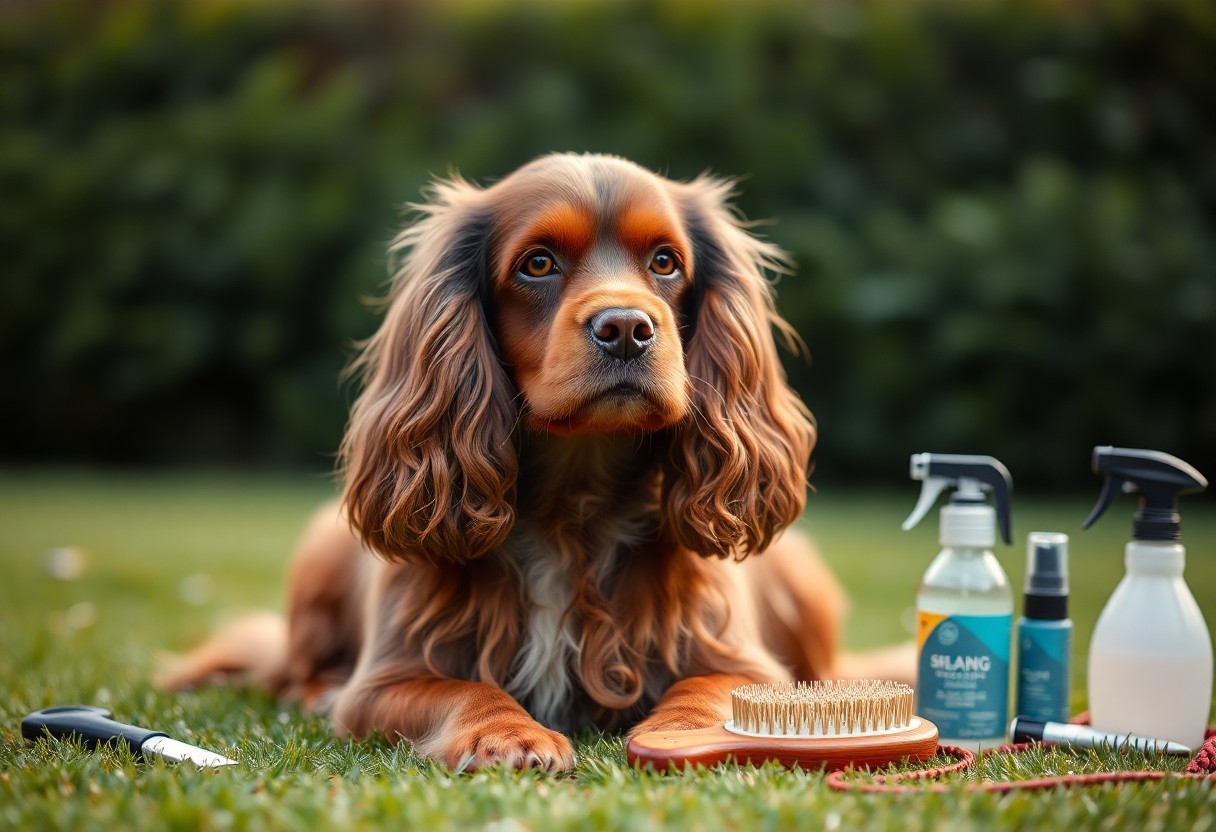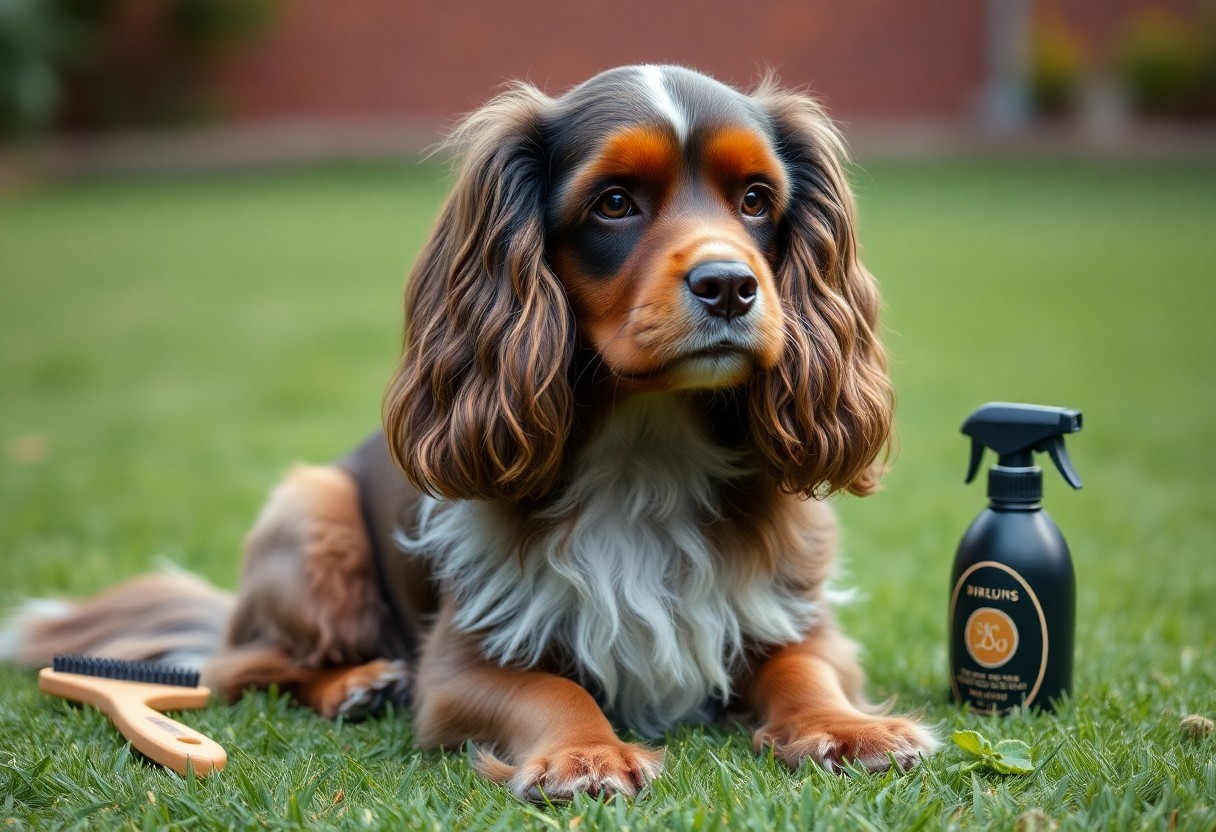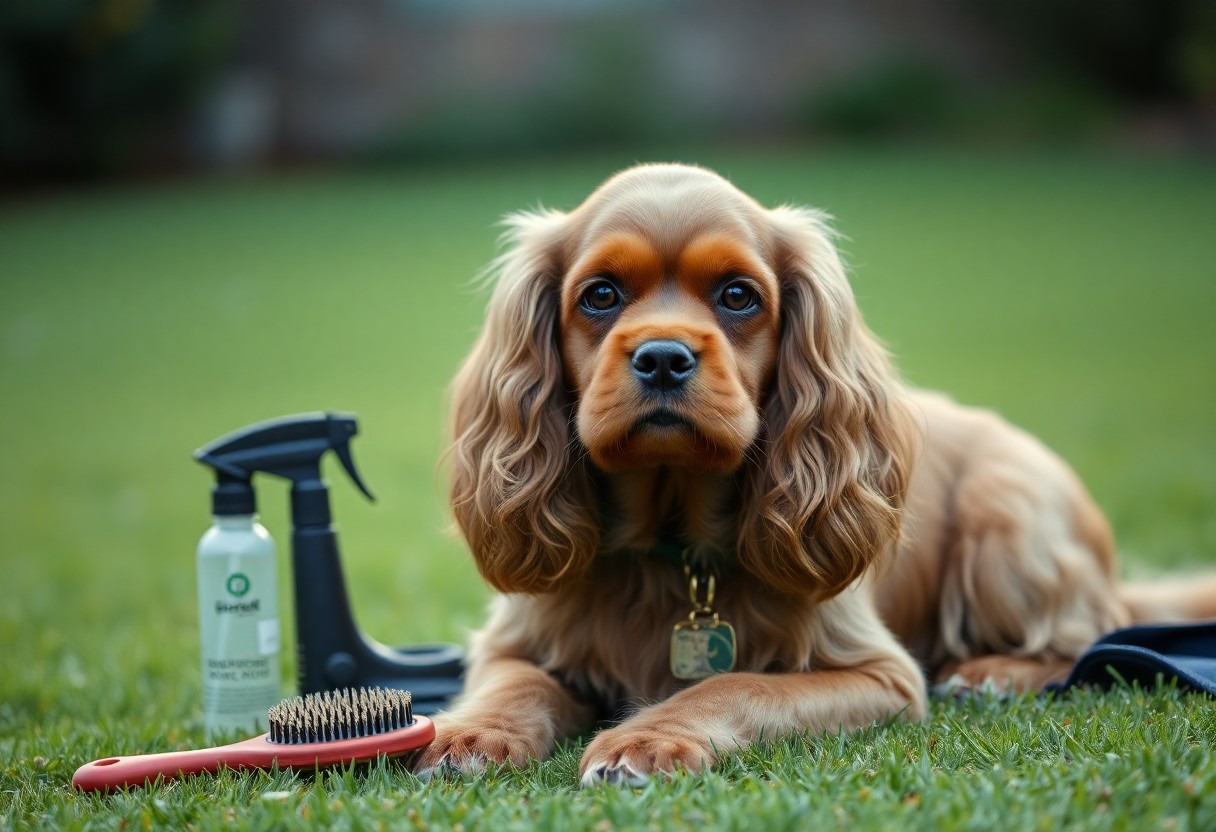Many Cocker Spaniel owners struggle with the persistent issue of mats in their dogs’ beautiful coats. Fortunately, with the right techniques and consistent grooming habits, you can keep your pup’s fur looking its best and free from tangles. Regular brushing, proper bathing techniques, and timely trims are crucial for maintaining a healthy coat. In this guide, you’ll learn practical steps to prevent mats from forming and ensure your furry friend stays comfortable and stylish all year round.
Key Takeaways:
- Regular grooming is imperative; brush your Cocker Spaniel’s coat at least 2-3 times a week.
- Use the right tools; a slicker brush and a comb can help detangle and remove loose hair effectively.
- Establish a bathing routine; wash your dog once a month, using a pet-friendly shampoo to keep the coat clean and healthy.
- Pay attention to high-mat areas; especially around the ears, armpits, and behind the legs where mats often form.
- Consider professional grooming services; regular visits to a groomer can help maintain coat health and prevent matting.
- Keep the coat trimmed; regular trims can help reduce tangles and mats, especially in areas prone to matting.
- Watch for skin issues; any skin irritation can lead to matting, so consult a vet if you notice excessive scratching or redness.
Understanding the Factors Contributing to Matting
The primary factors that contribute to matting in your Cocker Spaniel’s coat include coat type, grooming frequency, and environmental elements. Understanding these factors will assist you in preventing tangles and mats from forming. Consider the following:
- Coat type
- Grooming frequency
- Environmental elements
- Health issues
After identifying these factors, you can take proactive steps to maintain a healthy coat.
Coat Characteristics of Cocker Spaniels
Contributing to matting, the coat characteristics of Cocker Spaniels include their long, dense fur and wavy texture. These traits make their coats beautiful yet more susceptible to tangles. Frequent brushing is vital to keep the coat smooth and prevent mat formation.
Environmental Influences
On the other hand, environmental influences play a significant role in your Cocker Spaniel’s coat condition. Factors such as humidity, temperature, and outdoor conditions can affect fur quality. Dust, dirt, and moisture can cause tangles and mats to form more easily in your dog’s coat.
Spaniels are often exposed to varied environments, which can provide both challenges and benefits for their coat. Changes in humidity can cause your Cocker Spaniel’s coat to become frizzy or oily, leading to an increased likelihood of mats. Regular grooming sessions can help mitigate the negative effects of seasonal weather changes, while adventures in nature expose them to debris and dirt. To maintain a healthy coat, be alert to these environmental challenges and adjust your grooming routine accordingly.
How to Maintain a Healthy Coat
Some simple practices can make a significant difference in maintaining your Cocker Spaniel’s coat. Regular grooming not only keeps their fur looking great but also helps to remove dirt, debris, and loose hair that can contribute to matting. Establishing a routine that includes brushing, bathing, and checking for any skin issues will keep your dog’s coat healthy and free of tangles.
Regular Grooming Techniques
One of the most effective ways to maintain your Cocker Spaniel’s coat is to establish a regular grooming schedule. Aim to brush your dog at least a few times a week, or even daily during shedding seasons. This consistent practice will help prevent mats and tangles while also allowing you to assess the condition of their skin. Don’t forget to incorporate a bath every month or so to keep their coat clean and fresh.
Appropriate Tools for Brushing
Appropriate grooming tools can make a world of difference in your efforts to maintain your Cocker Spaniel’s coat. Invest in a high-quality bristle brush and a slicker brush, as these tools work together to detangle fur and remove loose hair effectively. Additionally, a wide-toothed comb can help with any stubborn knots or mats in areas prone to tangling, such as behind the ears and under the legs.
Regular use of the right tools ensures a smoother grooming experience for both you and your Cocker Spaniel. A bristle brush is excellent for distributing natural oils and keeping the coat shiny, while a slicker brush is perfect for tackling the undercoat and removing any tangles. Always approach grooming with patience, using gentle strokes and working through mats carefully to avoid pain or discomfort. Investing in these key tools will lead to a healthier, more manageable coat.
Bathing and Conditioning Tips
Unlike other breeds, a Cocker Spaniel’s coat requires special attention during bathing to prevent mats. To ensure optimal care, follow these tips:
- Use a gentle, moisturizing shampoo suitable for dogs
- Rinse thoroughly to remove all product residue
- Apply a high-quality conditioner to keep the coat hydrated
- Brush your dog’s coat while it’s wet to remove any tangles
Recognizing the importance of proper bathing techniques is vital for a healthy, mat-free coat. For more details, check How to Safely Remove Tangles from Your Pet’s Coat.
Choosing the Right Shampoo
Assuming you want a healthy and shiny coat for your Cocker Spaniel, selecting the right shampoo is vital. Look for products specifically formulated for dogs, ensuring they are free from harsh chemicals that can irritate the skin and coat. A pH-balanced shampoo will help maintain hydration and avoid stripping the natural oils vital for a soft, manageable coat.
Conditioning Treatments to Prevent Matting
Conditioning treatments can significantly help prevent matting in your Cocker Spaniel’s coat. These treatments not only hydrate the fur but also enhance its elasticity, making it less prone to tangles and knots.
Understanding which conditioning treatments are best for your dog is vital for maintaining their coat. Look for products that contain natural ingredients and intensive moisturizers. Regular use can provide a protective barrier against matting, while nourishing the coat. Opt for leave-in conditioners or detangling sprays that can help your Cocker Spaniel’s coat remain smooth and manageable between grooming sessions.
Nutrition and Coat Health
Your Cocker Spaniel’s coat health is significantly influenced by their nutrition. A balanced, high-quality diet is imperative for promoting a healthy, mat-free coat. When selecting food, look for options rich in omega fatty acids and imperative vitamins to enhance coat texture and shine. For more tips, check out Preventing Mats in Your Dog’s Fur: Tips and Tricks.
Diet’s Role in Coat Quality
An optimal diet is key to maintaining your Cocker Spaniel’s beautiful coat. Feeding them with high-quality proteins and healthy fats ensures their skin remains hydrated and nourished, which can greatly reduce the risk of matting. Consider incorporating whole foods that are rich in natural oils to support overall coat health.
Supplements for Luster and Strength
Strengthening your dog’s coat can be enhanced through the use of supplements designed for coat health. These supplements often include ingredients like fish oil, biotin, and zinc, which may help improve fur quality, making it shinier and less susceptible to tangling.
Another effective way to maintain your Cocker Spaniel’s coat is by using specific supplements that provide imperative nutrients for luster and strength. Look for products containing omega fatty acids, which are known to support skin and coat health, while biotin helps in fur growth and texture improvement. Always consult your veterinarian before introducing any new supplements to ensure they are safe and appropriate for your dog’s specific needs.
Professional Grooming Recommendations
Now, enlisting the help of a professional groomer can be an excellent way to keep your Cocker Spaniel’s coat healthy and free of mats. Look for groomers who specialize in breeds with similar coat types, as they will have the right techniques and tools to maintain your dog’s specific needs. Regular appointments, ideally every 4 to 6 weeks, can significantly reduce matting and keep your dog’s coat looking vibrant and healthy.
When to Seek Professional Help
An important aspect of your Cocker Spaniel’s grooming routine is knowing when to seek professional help. If you notice frequent mats forming despite your regular brushing, or if you feel overwhelmed managing your dog’s coat, it’s time to consult a professional. Additionally, if your Cocker Spaniel shows signs of discomfort or anxiety during brushing, a groomer’s expertise might be necessary to avoid further stress for you and your pet.
What to Expect from a Grooming Session
While each grooming session may vary, you can expect a consistent experience that includes brushing, bathing, and trimming your Cocker Spaniel’s coat. Additionally, the groomer will check your dog’s ears, teeth, and nails, ensuring overall health and cleanliness. A skilled groomer will use specialized tools to remove any mats gently, keeping your dog comfortable throughout the process.
This session is an opportunity to focus on your dog’s well-being, as a professional groomer will help identify any underlying skin issues or parasites. Expect a thorough, attentive examination of your Cocker Spaniel’s coat, which helps prevent issues from escalating. After the grooming, your dog should feel more relaxed and have a shiny coat. Grooming is not just about aesthetics; it also contributes to your dog’s overall health and happiness. Be sure to ask your groomer questions about coat maintenance to enhance your grooming routine at home.
Proactive Steps to Prevent Mats
Once again, maintaining your Cocker Spaniel’s coat health is crucial to keep it mat-free. Regular grooming and a few simple practices can make all the difference. Ensuring that you brush your dog’s coat frequently and addressing any tangles as they arise will help keep the fur smooth. Additionally, keeping an eye on the environment, like moisture and dirt, can further prevent matting. By taking these proactive steps, you can greatly reduce the likelihood of mats forming.
Daily Care Routines
Any dedicated dog owner knows that a consistent daily care routine is fundamental to avoid mats in your Cocker Spaniel’s coat. Aim to brush your dog at least once a day, focusing on areas prone to tangles, such as behind the ears and under the legs. This habit not only prevents mats but also allows you to check for skin issues or parasites, keeping your pet healthy and happy.
Seasonal Care Adjustments
Care for your Cocker Spaniel’s coat by making seasonal adjustments to your grooming routine. During summer, the humidity may lead to more tangles and shedding, while winter can introduce dirt and debris trapped in the coat. Adapting your grooming frequency and methods to the changing seasons will enhance their coat’s resilience against matting.
Adjustments to grooming routines during different seasons can drastically impact your Cocker Spaniel’s coat health. In warmer months, increased humidity can lead to excessive tangling, so you may find it beneficial to brush more frequently or opt for a lighter grooming product. Conversely, in colder months, your dog’s fur may trap more dirt and moisture, increasing the potential for mats. Regular trims and thorough brushing can help maintain their coat in both extremes of weather, leading to a healthier and more manageable coat overall.
Final Words
Hence, to effectively prevent mats in your Cocker Spaniel’s coat, you should establish a regular grooming routine that includes brushing several times a week and using the right tools. Additionally, maintaining a clean and healthy coat through proper bathing and conditioning will help minimize matting. For more insights on coat care, you can check out Why Your Dog’s Coat Gets Matted — and What You Can …. With these strategies in place, your dog’s coat will stay beautiful and manageable.
FAQ
Q: What causes mats in a Cocker Spaniel’s coat?
A: Mats usually form due to a combination of factors such as lack of regular grooming, moisture, dirt, and lack of proper coat care. The Cocker Spaniel’s long, wavy fur is prone to tangling, so it’s crucial to understand these factors to effectively prevent mats.
Q: How often should I groom my Cocker Spaniel to prevent mats?
A: It’s recommended to groom your Cocker Spaniel at least two to three times a week. This frequency helps to remove loose hair, dirt, and debris, reducing the likelihood of mat formation. Weekly baths followed by thorough brushing can enhance coat health as well.
Q: What tools should I use for grooming my Cocker Spaniel?
A: Ideal grooming tools for Cocker Spaniels include a slicker brush, a comb with both wide and fine teeth, and dematting combs for tougher tangles. Each tool serves a specific purpose in maintaining the coat’s health and preventing mats.
Q: How can I identify mats in my Cocker Spaniel’s coat?
A: Mats can appear as clumps of tangled fur that feel dense and tight against the skin. They may be found behind the ears, under the legs, or around the collar area. Regularly checking these areas, especially in humid conditions, can help in early identification.
Q: What should I do if I find a mat in my Cocker Spaniel’s coat?
A: If you encounter a mat, try to gently work it out using your fingers or a comb. Start at the edges and gradually work your way toward the base. For larger or tighter mats, it may be beneficial to use a dematting tool. In severe cases, seeking assistance from a professional groomer is advisable.
Q: Is there a specific bathing routine that can help prevent mats?
A: Yes, a consistent bathing routine is helpful. Aim to bathe your Cocker Spaniel every 4 to 6 weeks using a quality dog shampoo and conditioner. This helps to keep the coat clean and moisturized, reducing the chances of tangles when combined with regular brushing.
Q: Are there any products that can help reduce matting in a Cocker Spaniel’s coat?
A: Yes, you can use detangling sprays or conditioners specifically formulated for dogs. These products can make the coat more manageable and help reduce friction, which contributes to matting. Always choose a product suitable for your dog’s specific coat type.


